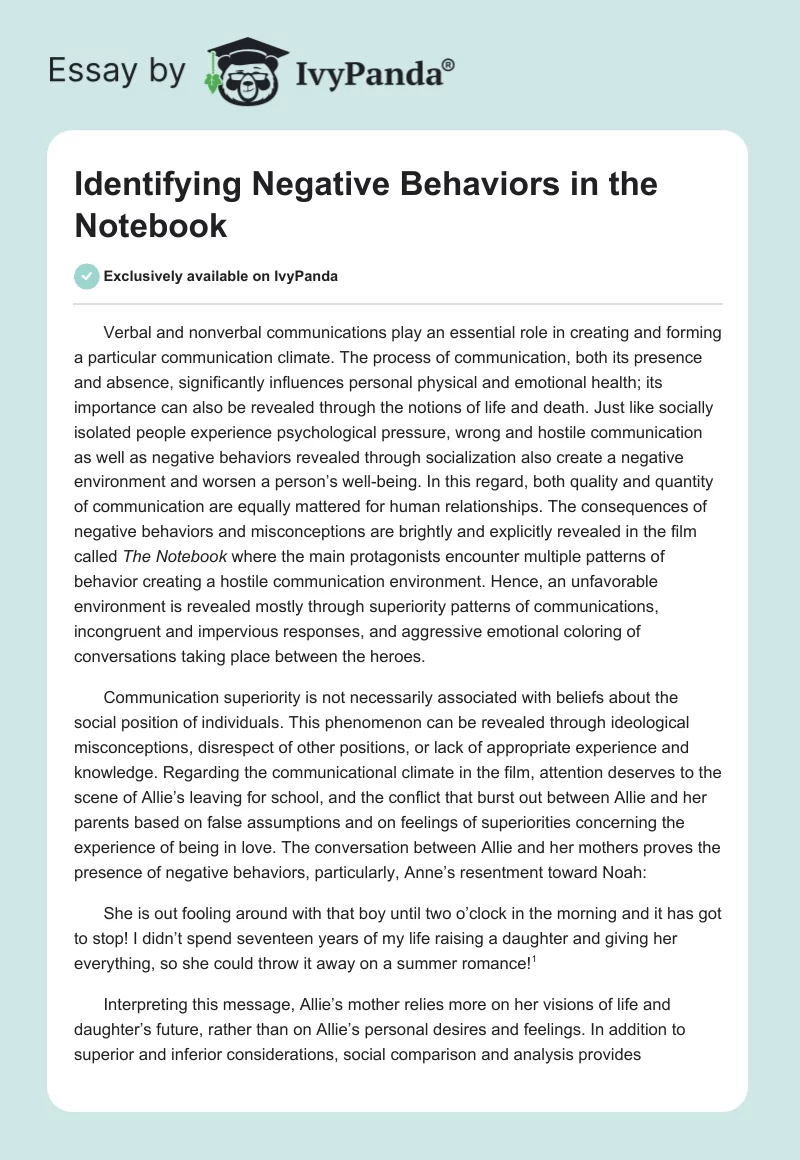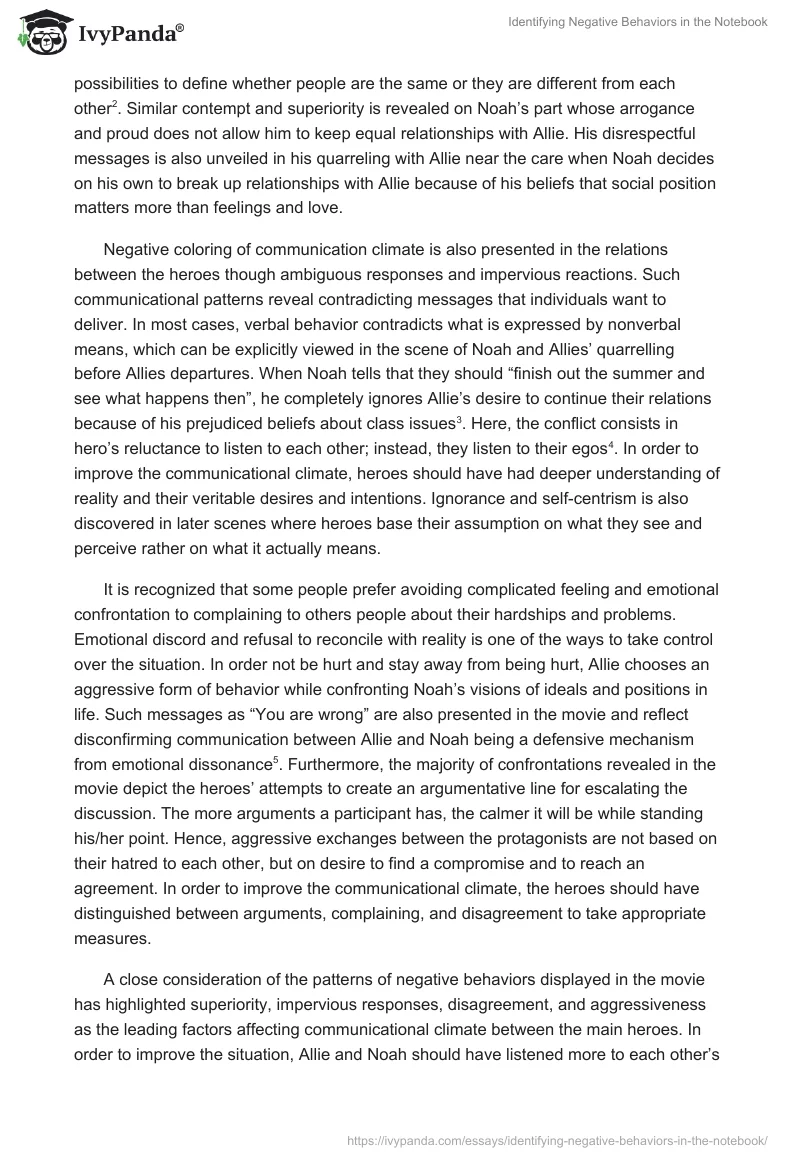Verbal and nonverbal communication plays an essential role in creating and forming a particular communication climate. The process of communication, both its presence and absence, significantly influences personal physical and emotional health; its importance can also be revealed through the notions of life and death. Just like socially isolated people experience psychological pressure, wrong and hostile communication as well as negative behaviors revealed through socialization also create a negative environment and worsen a person’s well-being. In this regard, both quality and quantity of communication are equally mattered for human relationships. The consequences of negative behaviors and misconceptions are brightly and explicitly revealed in the film called The Notebook where the main protagonists encounter multiple patterns of behavior creating a hostile communication environment. Hence, an unfavorable environment is revealed mostly through superiority patterns of communication, incongruent and impervious responses, and aggressive emotional coloring of conversations taking place between the heroes.
Communication superiority is not necessarily associated with beliefs about the social position of individuals. This phenomenon can be revealed through ideological misconceptions, disrespect of other positions, or lack of appropriate experience and knowledge. Regarding the communicational climate in the film, attention deserves to the scene of Allie’s leaving for school, and the conflict that bursts out between Allie and her parents based on false assumptions and on feelings of superiority concerning the experience of being in love. The conversation between Allie and her mothers proves the presence of negative behaviors, particularly, Anne’s resentment toward Noah:
She is out fooling around with that boy until two o’clock in the morning and it has got to stop! I didn’t spend seventeen years of my life raising a daughter and giving her everything, so she could throw it away on a summer romance!
Interpreting this message, Allie’s mother relies more on her visions of life and daughter’s future, rather than on Allie’s personal desires and feelings. In addition to superior and inferior considerations, social comparison and analysis provide possibilities to define whether people are the same or they are different from each other. Similar contempt and superiority is revealed on Noah’s part whose arrogance and pride does not allow him to keep equal relationships with Allie. His disrespectful messages is also unveiled in his quarreling with Allie near the care when Noah decides on his own to break up relationship with Allie because of his beliefs that social position matters more than feelings and love.
Negative coloring of communication climate is also presented in the relations between the heroes through ambiguous responses and impervious reactions. Such communicational patterns reveal contradicting messages that individuals want to deliver. In most cases, verbal behavior contradicts what is expressed by nonverbal means, which can be explicitly viewed in the scene of Noah and Allies’ quarreling before Allies departure. When Noah tells that they should “finish out the summer and see what happens then”, he completely ignores Allie’s desire to continue their relations because of his prejudiced beliefs about class issues. Here, the conflict consists in hero’s reluctance to listen to each other; instead, they listen to their egos. In order to improve the communicational climate, heroes should have had deeper understanding of reality and their veritable desires and intentions. Ignorance and self-centrism is also discovered in later scenes where heroes base their assumption on what they see and perceive rather on what it actually means.
It is recognized that some people prefer avoiding complicated feeling and emotional confrontation to complaining to others people about their hardships and problems. Emotional discord and refusal to reconcile with reality is one of the ways to take control over the situation. In order not be hurt and stay away from being hurt, Allie chooses an aggressive form of behavior while confronting Noah’s visions of ideals and positions in life. Such messages as “You are wrong” are also presented in the movie and reflect disconfirming communication between Allie and Noah being a defensive mechanism from emotional dissonance. Furthermore, the majority of confrontations revealed in the movie depict the heroes’ attempts to create an argumentative line for escalating the discussion. The more arguments a participant has, the calmer it will be while standing his/her point. Hence, aggressive exchanges between the protagonists are not based on their hatred to each other, but on desire to find a compromise and to reach an agreement. In order to improve the communicational climate, the heroes should have distinguished between arguments, complaining, and disagreement to take appropriate measures.
A close consideration of the patterns of negative behaviors displayed in the movie has highlighted superiority, impervious responses, disagreement, and aggressiveness as the leading factors affecting communicational climate between the main heroes. In order to improve the situation, Allie and Noah should have listened more to each other’s concerns and to their actual goals and desires rather on external factors setting them under the pressure. Tough emotional environment and reluctance to consider each other’s message have led to increased aggressiveness and arrogance.
Reference List
Adler, R., & Proctor, F. (2004). Looking Out Looking In. Boston: Wordsworth Publishing. Print.
Cassavetes, N. (Director) (2004). The Notebook. [Motion picture]. USA: New Line Cinema.


